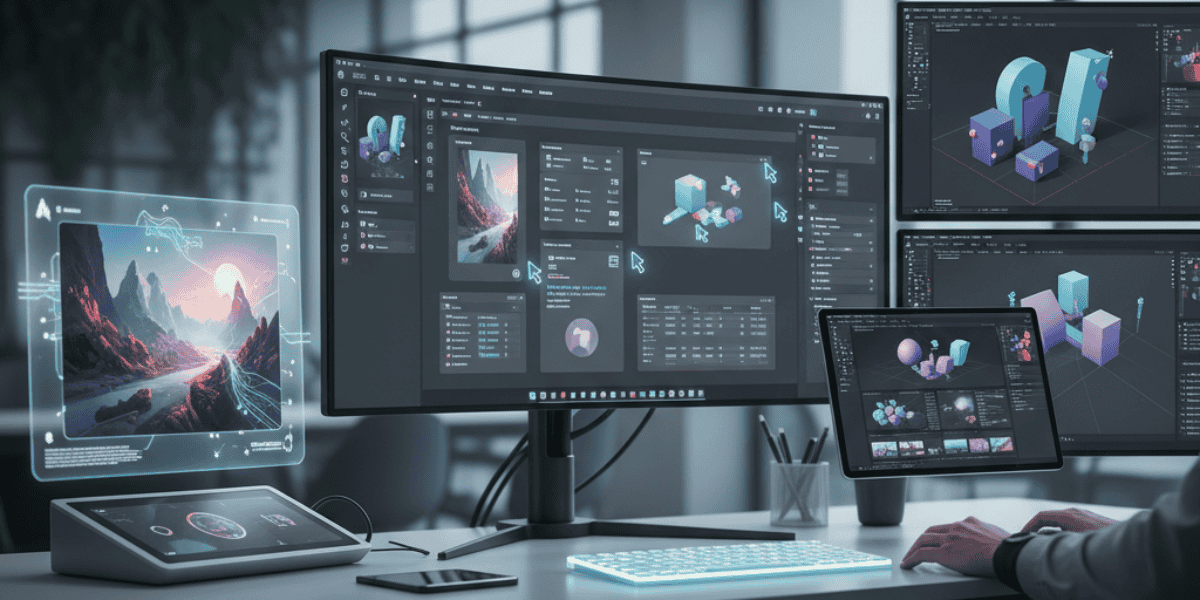In a world saturated with digital and print media, standing out as a creative designer demands more than technical skill. It requires a strategic mix of imagination, experimentation, and user focus to craft visuals that captivate and compel audiences. This comprehensive guide explores ten cutting-edge design strategies alongside essential tools and principles to help you elevate your creative process and deliver engaging visual experiences across platforms.
10 Cutting-Edge Creative Design Strategies
- Leverage Generative AI for Concept Exploration
Generative AI is revolutionizing creative design by enabling rapid production of diverse visual concepts based on text prompts or design parameters. By feeding AI with mood boards, color guidelines, or rough sketches, you can uncover unexpected variations and accelerate the ideation phase. This transformative approach frees your creative energy to refine bold ideas instead of spending hours on manual mockups during early brainstorming stages. - Adopt Bold Typography Experiments Typography can make or break a design’s impact. Experiment with variable fonts, oversized headlines, and custom letterforms to create unique visual hierarchies. Mixing abstract type treatments with legible layouts can draw attention to key messages while preserving readability. Don’t be afraid to push boundaries by weaving type into illustrations or photo compositions for a memorable effect.
- Integrate Motion and Microinteractions. Adding subtle animations and microinteractions brings static layouts to life and enhances user engagement. Use hover effects, scroll-triggered transitions, or small feedback animations to guide viewers through content and reinforce brand personality. Thoughtful motion design helps communicate complex ideas more intuitively and makes digital experiences feel more dynamic and polished.
- Use Variable Color Palettes Dynamic color systems, such as variable hue ranges or interactive gradients, allow for flexible branding that adapts to different contexts. By defining modular color rules, you can maintain visual consistency while introducing vibrancy and nuance. Experiment with duotones, color duels, or monochromatic schemes to evoke specific moods and direct attention within your designs.
- Embrace Mixed Media and Textures Combining hand-drawn illustrations, photography, and 3D renders adds depth and authenticity to your visuals. Incorporate scanned paper textures, brush strokes, or collage elements to introduce organic imperfections that contrast with digital precision. Mixed media approaches convey craftsmanship and can help your designs stand out in a sea of flat graphics.
- Design with AR and VR in MindAugmented and virtual reality experiences are rapidly gaining traction across industries. Even if you’re designing for 2D screens, consider how spatial layouts and interactive elements might translate into immersive environments. Planning for 3D assets, user navigation, and real-world integration will future-proof your skill set and expand your creative possibilities.
- Optimize for Accessibility and Inclusion Inclusive design is both an ethical imperative and a way to reach broader audiences. Ensure color contrast ratios meet guidelines, provide clear typographic hierarchy, and consider alternative text for images. Designing with accessibility tools in mind—like screen readers or keyboard navigation—will make your work more usable and showcase your commitment to universal experiences.
- Implement Data-Driven Design Decisions Leverage analytics and user testing insights to guide your creative choices. A/B tests on color schemes, layouts, or call-to-action treatments can reveal what resonates best with your audience. By marrying data with intuition, you optimize both aesthetics and conversion performance, ensuring your designs deliver measurable results.
- Personalize User Experience with Dynamic Content Tailoring visuals based on user preferences or behavior enhances relevance and engagement. Implement dynamic banners, content modules, or adaptive illustrations that change based on user location, browsing history, or time of day. Personalization fosters a deeper emotional connection and encourages repeat interactions.
- Collaborate Cross-Disciplinarily Working with copywriters, developers, marketers, and product managers unlocks fresh perspectives and prevents creative silos. Cross-functional collaboration ensures that your designs align with brand strategy, technical feasibility, and user needs. Collective brainstorming often sparks breakthrough ideas that would not emerge in isolation.
Embracing Cutting-Edge Tools and Technologies

To implement these strategies effectively, you need a versatile toolkit that blends innovation with reliability. Start by integrating cloud-based design platforms that enable real-time collaboration and version control, such as Figma or Adobe XD. Experiment with AI-driven image editing tools like Runway ML or Adobe Sensei to automate repetitive tasks and unlock advanced effects. For 3D and motion work, software like Blender or Cinema 4D offers powerful capabilities at accessible price points. Additionally, plugin ecosystems—such as Sketch plugins or Photoshop extensions—let you customize workflows and integrate directly with project management tools. By staying current with emerging technologies, you streamline your process, scale creative output, and maintain a competitive edge in a rapidly evolving landscape.
Incorporating User-Centric Design Principles
At the heart of every successful creative design lies a deep understanding of user needs and behaviors. Conduct user research through surveys, interviews, or usability tests to gather qualitative insights. Create empathy maps and user personas to humanize your target audience and align your visual decisions with their preferences. Employ journey mapping to identify key touchpoints and emotional highs or lows throughout the experience. Use iterative prototyping to validate concepts before full-scale production and gather feedback early. By centering your process on real user data, you ensure that aesthetics serve functionality, resulting in designs that are not only beautiful but intuitive and impactful.
Cultivating a Continuous Innovation Mindset
True creative excellence requires more than mastering tools and techniques—it demands an ongoing commitment to learning and experimentation. Schedule regular design sprints or hack days to explore new ideas outside client constraints. Follow industry blogs, participate in online communities, and attend design conferences to stay inspired by peers and emerging trends. Keep a swipe file of inspiring work, but challenge yourself to reinterpret rather than replicate. Maintain a growth mindset by soliciting constructive critique and reflecting on project outcomes. By fostering a culture of curiosity and resilience, you equip yourself to navigate shifting trends and continue delivering groundbreaking visuals over the long term.
Conclusion
Innovation in creative design is an evolving journey that blends strategy, technology, and human insight. By adopting these ten cutting-edge strategies, leveraging powerful tools, and committing to user-centric and innovative mindsets, you can elevate your work and craft visuals that truly engage. Start implementing these approaches today to transform your design process and set a new standard for creativity in your projects.
Learn more about: Mastering Color Psychology in Creative Design: Boost User Engagement with the Right Palette









